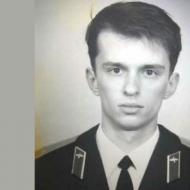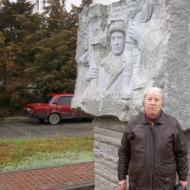
General Shumilov 64th army. Hero of the Soviet Union Mikhail Stepanovich Shumilov
Mikhail Stepanovich Shumilov
In the photo: Lieutenant General M.S. Shumilov. Stalingrad. 1943 Beketovka.
N. Virta told the Pravda newspaper by telephone: “Stalingrad. 1st of February. So, it's done! Over Stalingrad, over its central part, the red flag is again fluttering. Let the whole country remember this date – January 31, 1943.” British Prime Minister W. Churchill in a message to I.V. On February 1, 1943, he wrote to Stalin: “... please accept my congratulations on the occasion of the surrender of Field Marshal Paulus and on the occasion of the end of the 6th German Army. This is truly an amazing victory."
Extract from the operational report No. 32 (705) of the General Staff of the Red Army at 8.00 1.02.43: “10. Don front. During January 31, 1943, the troops of the front continued to fight to destroy the remnants of the enemy troops in the Stalingrad region. The commander of the 6th German Army, Field Marshal von Paulus and the Chief of Staff of the Army, Major General Schmidt, with the headquarters of the 6th Army, surrendered to our troops and at 15.00 on 31.01.43 were taken to the headquarters of the 64th Army. The command of the Southern Group of Forces, surrounded in the central part of Stalingrad, Paulus handed over to the commander of the 71st Infantry Division, who ordered the troops to cease hostilities and himself surrendered. The southern group of enemy troops stopped organized hostilities. Our units are receiving enemy soldiers and officers who surrender and at the same time clear individual buildings of small groups of officers and SS men who have settled in them and are resisting. The northern group of the enemy continues to put up stubborn organized resistance.
In the story of my fellow countryman Viktor Nikolaevich Drobotov, “January was ending,” the events are described as follows ...
... yes, it all happened on January 31, 1943 in the city of Stalingrad. The final victory came to Stalingrad on February 2, 1943. But the beginning, its anchors, the anchors of victory were thrown on January 31st. Sometimes we remember in a strange way. Feeling - we remember as it is convenient for us, but we would like to be remembered in truth. And not only individual heroes, but all those - from the private to the marshal - whose names we have no right to ever forget. I'm a Becket girl from the war. Shumilovtsy filled our entire district. They stood to the death.

Now the assessment of the role of the troops of the 64th Army is expressed simply: “Thanks to the stamina and perseverance of the troops of the 64th Army, Stalingrad survived” (Soldiers of the XX century. Issue III. T.I. M., 2003. P. 68). In no way do I want to exceed the role of the 64th Army. I collect and analyze materials about the soldiers of the 64th Army who defended my small homeland. For what? Firstly, I would like to know more fully the history of my beloved Beketovka. Secondly, so that the younger generations know the history and heroes, so that they are proud of them. Thirdly, to respect veterans and not break the connection between generations.

We go on an excursion with schoolchildren and even kindergartens to the house on Krasnoufimskaya Street (formerly Kalanchevskaya) in Beketovka. We see the house where the headquarters of Mikhail Stepanovich was. We read the memorable words on the memorial plaque, and the most valuable thing is that on the side of the house there is an inscription from those terrible heroic years:
"GLORY TO THE SOLDIERS OF THE RED ARMY WHO SUCCESSFULLY IMPLEMENTED THE ENVIRONMENT."
There is a photo, and more than one, where M.S. Shumilov, A.S. Chuyanov with a group of comrades are standing near this house, which housed the headquarters of the 64th Army. Here, at a carved table with a table lamp with green glass, they brought the surrendered German Field Marshal Paulus and 16 captured generals for interrogation to Lieutenant General Shumilov. It was in my native Beketovka. All this remained forever in the history of the Battle of Stalingrad. The heroic defense of Stalingrad remained for humanity as a memory to know it and understand that henceforth such barbarism should never be repeated on Earth.

In the photo in the center:
Alexey Semyonovich Chuyanov - First Secretary of the Stalingrad Regional Committee and City Committee of the All-Union Communist Party of Bolsheviks, Chairman of the City Defense Committee 1941-1945. and commander of the 64th Army, Lieutenant General Mikhail Stepanovich Shumilov. Stalingrad. 1943 Beketovka.
PEOPLE, PROTECT THE WORLD AND THE EARTH! STALINGRAD TEACHES THIS.
How do we remember history? October 20 this year I am taking a tour of the halls of the Panorama Museum "Battle of Stalingrad". I listen attentively to the wonderful guide, but ... We somehow casually pass by a table with a green lamp, under which Shumilov, Paulus and others were sitting. They were interrogated, and there was a historical event. Let me express my feeling from the tour: “Perhaps it would be better to keep all these exhibits in the house where they were. The panoramic museum is amazing. It has a huge number of interesting exhibits. Each one requires his own separate story, and not just passing by and information in passing.
When in the Kirov region, on the initiative of the search detachment "The Fire of Memory" named after Sergeev A.N. and with the support and assistance of the Kirov RVC, the council of veterans and the administration of the district and the hero city of Volgograd, on May 7, 2005, the first monument in the country was opened - a bust to the legendary commander M.S. Shumilov, people said this: “It’s good that after many years, but they did it. This man deserves people's memory” (veterans); “To my shame, I'm sorry, but I don't know who Shumilov is” (young 30-year-old man). Under the bust is written very simply and very modestly "Shumilov M.S." A request to those who can solve this issue and make a decent inscription:
“Veterans and residents of the Kirovsky district of the hero city of Volgograd are asked to decipher who he is, Shumilov M.S., what are his merits?”

This request is correct. We hope for your understanding on this matter. I would like to believe that someday (perhaps in the near future) guests will again come to the Kirovsky District, to Krasnoufimskaya Street, 20, on an excursion. So it was after the war, when high military officials, excursions from the USSR and Germany, came and saw where the first interrogation of Paulus was carried out. The department store has an interesting museum "Memory", but ... bring Paulus to us in Beketovka (as it used to be in 1943 on January 31), i.e. take the sightseers to us. But for this it is necessary to make a museum of the legendary Lieutenant General Shumilov, the first interrogator of the field marshal, no less worthy. The military is not supposed to, but it happened that the lieutenant general interrogated the field marshal, and this is true, stories. I would like to believe that we will learn to honor our heroes deeply, sincerely, fully and with dignity.

In the photo, Mikhail Stepanovich Shumilov, far right

Mikhail Shumilov's wife and son
Mikhail Stepanovich Shumilov was born in 1895 on November 18, died in 1975 on June 28. In the Kirovsky district there is a street named after General Shumilov. On the pre-war house there is a memorial plaque telling about M.S. Shumilov. The kids of kindergarten No. 214, schoolchildren of school No. 139, gymnasium No. 9, and others come to her, hold rallies, talks, and lay flowers. Residents of Beketov-Kirov remember and love Mikhail Stepanovich. He was a frequent visitor to Beketovka after the war. This man was very modest and spoke more often about his soldiers than about himself. Marshal of the Soviet Union A.I. Eremenko spoke about Shumilov: “I remember how, in especially difficult moments, he spoke in a calm Basque: “We do not lose heart, Comrade Commander, please do not worry about us, we will complete the task.” This confidence of the commander was transmitted to every soldier of the army, who unshakably defended the Stalingrad land and really fought to the death.
“Army Commander General M.S. Shumilov had good military knowledge and rich practical experience. Outwardly, he gave the impression of being phlegmatic, but in fact it turned out that at the right moments he was very energetic and decisive, ”Marshal of the Soviet Union K.K. Rokossovsky characterized him.
“Major General Mikhail Stepanovich Shumilov (now Colonel General) is a man of great soul, has a broad military and political outlook, strong will and high demands,” writes Marshal of the Soviet Union A. I. Eremenko. On the fronts of the Great Patriotic War Shumilov from the first to the victorious day. After the Battle of Stalingrad, the 64th Army was transformed into the 7th Guards. The soldiers, his guards-fighters, loved their commander and sang a song about him ...
The title of Hero of the Soviet Union was awarded to Mikhail Stepanovich Shumilov in October 1943. The motherland highly appreciated the merits of M. S. Shumilov, conferring the title of Hero of the Soviet Union and awarding him three Orders of Lenin, four Orders of Kutuzov I degree, the Order of the Red Star, many medals, as well as foreign awards. In May 1970, M.S. Shumilov was awarded the title of honorary citizen of the hero city of Volgograd. He is also an honorary citizen of the cities of Bratislava, Belgorod, Balti and his native village of Upper Techa, Kurgan region. An obelisk was erected on Bald Mountain in the Sovetsky district of the hero city of Volgograd in memory of the exploits of the 64th (7th Guards) Army of General Shumilov. In November 2006, Mikhail Stepanovich Shumilov would have turned 111 years old. When you meet veterans who served with him, you see photographs of him in our Kirov Palace of Culture, at Factory No. 91 (now Khimprom) or in a boarding school with children, you feel him as a simple person.

Photo: 1943. General Shumilov and the children of Stalingrad.
And here is a photo of 1943, January 31. Beketovka. Headquarters of the 64th Army. There are two - Shumilov and Chuyanov. They are waiting for the arrival of Paulus. Two real Russian peasants, two reliable people did their hard military work well. They defended the house, the Motherland, childhood, the world. Mikhail Stepanovich had a son, Igor, his blood. He also participated in the war.

M.S. Shumilov and son
When the son was presented for the award, his father crossed out his last name and told him: “We are fighting and defending the Motherland not for awards.” In this Shumilov is a general and a man. He did everything for the Motherland, the Motherland remembers its hero-son.
From the combat diary of the Wehrmacht Supreme High Command:
Eastern Front: January 31, 1943. In Stalingrad, despite heroic resistance, the defense of the southern pocket fell. The army headquarters organized a circular defense with the forces of the last units within a radius of 300 m around Red Square (as they called the Square of the Fallen Fighters. - D.V.). On January 31, in the morning, the last radiogram was received from the southern group led by Field Marshal Paulus. Thus, their resistance ceased.
Eastern Front: February 1, 1943. The 6th Army (southern pocket) handed over on January 31 at 07:45. His last radiogram: “The Russians are at the door, we are preparing destruction. We destroy." (Stalingrad, 1942-1943. Battle of Stalingrad in documents. M., 1995, pp. 371-372). The Pravda newspaper wrote: “That was the beginning. The dam broke. The remnants of tank, cavalry and other units began to surrender. The streets of Stalingrad were again filled with fascists, but already unarmed, thin, unshaven, dressed in rags. They climbed out of the dugouts with their hands up, holding machine guns between their legs. The prisoners could not be counted. Thousands of them gathered in the squares. Many wandered the streets and asked the typical question: “Where is the prisoner here?”
... Ilya Ehrenburg wrote in the Krasnaya Zvezda newspaper: “The Germans call the encirclement a “cauldron”. Well, the big Stalingrad cauldron has boiled away. But the Germans now have to get used to the surroundings: there are quite a lot of boilers and cauldrons, and fritz are cooked in each of them. We are now also used to something: we are used to beating the Germans in bulk, and we will carry this matter through to the end.
SHUMILOV Mikhail Stepanovich, (November 5, 1895, the village of Verkhnyaya Techa, now the Katai district of the Kurgan region - June 28, 1975, Moscow). Russian. Colonel General (1943). (26.10.1943).
Served in the Russian army in 1916-1917, ensign. Member of the First World War on the Western Front, junior officer of the Kremenchug regiment.
In the Red Guard since 1917. In the Red Army since 1918. Graduated from the Chuguev Infantry School (1916), courses for senior and senior command and political staff (1924), shooting and tactical improvement courses for the command staff of the Red Army "Shot" them. Comintern (1929), VAK at the Higher Military Academy. K. E. Voroshilova (1948).During the Civil War, M. S. Shumilov fought on the Eastern and Southern fronts, commander of a platoon, company, regiment.
In the interwar period, M.S. Shumilov was the commander of a rifle battalion, chief of staff of a rifle regiment, since 1929 commander-commissar of a rifle regiment, since 1933 chief of staff of a rifle division, since 1937 commander of a rifle division. Participated in the national revolutionary war of the Spanish people in 1936-1939. Since April 1938, the commander of the 11th BOVO Rifle Corps, which took part in the Red Army's campaign in Western Ukraine and Western Belarus in 1939, as well as in the Soviet-Finnish war of 1939-1940. Since July 1940, the corps under the command of Major General M.S. Shumilov became part of the 8th Army of PribOVO.
At the beginning of the Great Patriotic War, the corps as part of the 8th Army of the North-Western Front fought stubborn battles in the border battle in Latvia. In the period from June 23 to 25, he participated in a front-line counterattack on the broken formations of the 4th enemy tank group in the Siauliai UR area. Subsequently, the corps as part of the army with battles retreated in the direction of the city of Riga and further to Tartu (now the Republic of Estonia). In July, the corps as part of the same army of the Northern Front fought heavy defensive battles at the turn of Pärnu, Tartu. WITH 22 By July 25, the enemy managed to break through the front defenses, reach Lake Peipus and surround the corps formations. By July 30, parts of the corps managed to break out of the encirclement. On August 6, the enemy managed to split the army troops into 2 groups. The 11th Rifle Corps, forming the basis of the eastern grouping of the army, defending from Lake Peipsi to the Gulf of Finland, held back the German offensive along the Narva highway with a stubborn defense. Since August 1941, M. S. Shumilov was deputy commander of the 55th Army of the Leningrad Front, which defended the southern approaches to Leningrad. Since November, at the disposal of the GUK NPO. Since January 1942, the deputy commander of the 21st Army as part of the Southwestern (from July Stalingrad) Front, participated in the Battle of Kharkov in 1942. During the hostilities, M. S. Shumilov showed high organizational skills, courage, determination, exactingness, quickly navigated in battle, drew the right conclusions from the situation, confidently made decisions and firmly implemented them. From August 1942 until the end of the war, M. S. Shumilov was the commander of the 64th Army (reorganized on April 16, 1943 into the 7th Guards), which operated as part of the Stalingrad, Don, Voronezh, Steppe and 2nd Ukrainian fronts . The troops under the command of M. S. Shumilov fought heroically near Stalingrad and, together with the 62nd Army, defended it from the enemy in the city itself. M. S. Shumilov skillfully commanded the army during the Battle of Kursk,
battles for the Dnieper, Kirovograd, Uman-Botoshansky, Iasi-Chisinau, Debrecen, Budapest, Bratislava-Brnovskaya and Prague offensive operations. The commander of the 2nd Ukrainian Front, Marshal of the Soviet Union R. Ya. Malinovsky, spoke highly of M. S. Shumilov, describing him as an energetic and well-prepared commander, capable of directing major military operations, a skilled organizer of the interaction of all branches of the armed forces throughout the battle. For the skillful leadership of the troops and the heroism shown, M.S. Shumilov was awarded the title of Hero of the Soviet Union. Considerable merit belongs to M. S. Shumilov in creating units of the new Romanian army and establishing interaction with its units and formations.
After the war, M. S. Shumilov - commander of the army. Since 1948, the commander of the troops of the BelVO, since 1949, Voronezh-VO. Retired since 1956. On April 24, 1958, he was returned to the ranks of the Armed Forces and was appointed military consultant to the Group of General Inspectors of the USSR Ministry of Defense.
Awarded 3 Orders of Lenin, 4 Orders of the Red Banner, 2 Orders of Suvorov 1st Class, Orders of Kutuzov 1st Class, Orders of the Red Star, Orders of "For Service to the Motherland in the Armed Forces of the USSR" 3rd Class, medals, and foreign orders.
SHUMILOV Mikhail Stepanovich, Soviet military commander. Colonel General (1943). Hero of the Soviet Union (10/26/1943).
Born into a peasant family. He graduated with honors from a rural school in 1911 and entered the teacher's seminary in Chelyabinsk, where he studied until July 1916. Then he was mobilized for military service and sent to the Chuguev Military School, after which he was appointed a junior officer in the 109th reserve regiment in Chelyabinsk. In March 1917, he left this regiment for the Western Front, where he fought as part of the 32nd Kremenchug Regiment as a junior company officer. In December of the same year, as a teacher, he was demobilized. From January 1918 he worked as a rural teacher, and in March he was appointed volost military commissar, at the same time he studied at land surveying courses. In the Red Guard since April 1918; participated in the suppression of the rebellion of the Czechoslovak Corps.
In the Red Army since May 1918: platoon commander, company commander and assistant commander of the 4th Ural Regiment of the 29th Infantry Division. In 1919 he was appointed commander of the 85th Special Rifle Brigade, which later crossed the Sivash and stormed Perekop. Later he fought with the armed formations of Ataman N.I. Makhno in the Gulyai-Pole area. From July 1921 M.S. Shumilov commanded a battalion in the 58th Infantry Regiment of the 7th Infantry Division of the Kharkov Military District, and later commanded a battalion and regiment in the 20th Infantry Regiment of the same division.
After graduating in June 1924 from the higher Kharkov repeated courses of the command and political staff, he served in leadership positions in the regimental level of the same division. After graduating in November 1929 from the Shooting and tactical improvement courses for the command staff of the Red Army "Shot" named after. Comintern, he was appointed commander and military commissar of the 21st Infantry Regiment of the 7th Infantry Division of the Ukrainian Military District (UVO). In December 1933 M.S. Shumilov was appointed chief of staff of the 96th Infantry Division of the UVO, then assistant commander of the 87th Infantry Division. In November 1935 he was awarded the military rank of colonel.
In June 1937, Shumilov was promoted to the rank of brigade commander, and he was appointed commander of the 7th Infantry Division of the Kyiv Military District. In the period from February 1938 to May 1939, as an adviser to the commander of the Republican Army Group of the Central-South Zone, he volunteered to participate in the Spanish Civil War. Upon returning to his homeland, he was appointed commander of the 11th Rifle Corps of the Belarusian Special Military District. Member of the campaign of the Red Army in Western Belarus in 1939. In January - March, commanding the 11th Corps, he participated in the Soviet-Finnish War of 1939-1940. In June 1940 he was awarded the military rank of major general. Since July 1940, the corps under his command became part of the 8th Army of the Baltic Special Military District.
At the beginning of the Great Patriotic War, the corps under his command as part of the 8th Army of the North-Western Front fought defensive battles on the territory of Latvia. Subsequently, the corps with battles retreated in the direction of Riga and further to Tartu, and later fought heavy defensive battles in Estonia at the turn of Pärnu and Tartu. Since August 1941, Major General M.S. Shumilov is the deputy commander of the 55th Army of the Leningrad Front, which defended the southern approaches to Leningrad, and in December he was appointed commander of the emerging 1st Special Rifle Corps, but did not actually command it. In January 1942, Shumilov was appointed deputy commander of the 21st Army as part of the Southwestern Front. In this position, in May, he participated in the Battle of Kharkov in 1942.
From August 1942 M.S. Shumilov took command of the 64th Army, which had been defending the southwestern outskirts and southern part of Stalingrad since September. After the enemy broke through the defenses of the front at the junction with the 62nd Army and his troops reached the Volga in the Kuporosnoye area, the main forces of the army defended the area south and southwest of Stalingrad, repeatedly launching counterattacks on the flank of the enemy grouping trying to capture the city. During the transition to the counteroffensive, the army acted as part of the main strike force of the Stalingrad Front. In December 1942, Shumilov was awarded the military rank of lieutenant general. In January 1943, the army became part of the Don Front and participated in the elimination of the encircled group of Nazi troops near Stalingrad. After the completion of the Battle of Stalingrad, the army was transferred to the Voronezh Front and fought defensive battles on the river. Seversky Donets near Belgorod. By the directive of the Headquarters of the Supreme High Command of April 16, 1943, it was transformed into the 7th Guards Army for distinction in the battles near Stalingrad.
In October 1943, Shumilov was awarded the rank of Colonel General. Later, General M.S. Shumilov skillfully commanded the army during the Battle of Kursk, the Battle of the Dnieper, Kirovograd, Uman-Botoshansky, Iasi-Kishinev, Debrecen, Budapest, Bratislava-Brnov and Prague offensive operations. At the final stage of the war, considerable merit belongs to General M.S. Shumilov in creating units of the new Romanian army, in establishing friendly relations and fraternal solidarity between Romanian and Soviet soldiers and officers.
After the war, Colonel General M.S. Shumilov continued to command the 64th Army. In February 1946, he was appointed commander of the 52nd Army in the Lvov Military District. Since June of the same year, he commanded the 13th Army as part of the Carpathian Military District. After graduating in 1948 from the VAK at the Higher Military Academy. K.E. Voroshilov was appointed commander of the White Sea Military District. In May 1949, he was transferred to the post of commander of the Voronezh Military District. From October 1955 to January 1956, he was at the disposal of the Minister of Defense of the USSR, then in January 1956 he was dismissed for health reasons. By a decree of the Council of Ministers of the USSR of April 24, 1958, Shumilov was again returned to the cadres of the Soviet Army and was appointed military consultant of the Group of General Inspectors of the USSR Ministry of Defense. He was buried on Mamaev Kurgan in Volgograd.
Awarded: 3 orders of Lenin, 4 orders of the Red Banner, 2 orders of Suvorov 1st class, orders of Kutuzov 1st class, Red Star, "For service to the Motherland in the Armed Forces of the USSR" 3rd class; foreign orders, including: Great Britain - the Military Order of the Empire twice; Poland - "Revival of Poland" 1st class, as well as many Soviet and foreign medals.
SHUMILOV Mikhail Stepanovich
Mikhail Stepanovich Shumilov was born in 1895 in the village of Verkhnyaya Techa, Kataisky District, Kurgan Region, into a peasant family. Russian by nationality. Member of the CPSU since 1918.
After graduating from the teacher's seminary in 1916, he was mobilized into the tsarist army. In 1918 he voluntarily joined the Red Army. He commanded the 4th Ural Regiment, formed in Shadrinsk and taking part in battles with the White Guards on the Eastern and Southern fronts.
During the Great Patriotic War, he commanded the 64th and 7th Guards Armies.
By decree of the Presidium of the Supreme Soviet of the USSR of October 26, 1943, Colonel General Mikhail Stepanovich Shumilov was awarded the title of Hero of the Soviet Union with the Order of Lenin and the Gold Star medal for forcing formations and units of the army on the Dnieper River. He was also awarded two Orders of Lenin, four Orders of the Red Banner, two Orders of Suvorov I degree, the Order of Kutuzov I degree and many medals.
After the end of World War II, he continued to serve in the Soviet army, holding high command positions. Currently, Colonel-General Shumilov is retired. Lives in Moscow.
TALENT OF THE COMMANDER
Mikhail Stepanovich Shumilov is one of the outstanding Soviet generals. The units and formations that he commanded wrote many glorious pages in the history of our Motherland, in the history of the Great Patriotic War. The remarkable victories of our troops are associated with the name of Shumilov.
In 1916, he was drafted into the army and after a short military training sent to the front. After demobilization, he returned to his native land and in March 1918, together with fellow front-line soldiers, established Soviet power in his native village, and then, on a business trip from local authorities, went to survey courses in Shadrinsk. Here in April 1918 he joined the ranks of the Communist Party and took up his studies with even greater energy.
When the young Soviet Republic found itself in the dangerous circle of civil war fronts, M.S. Shumilov organized a volunteer detachment from among the students of land surveying courses, which then joined the 4th Ural Regiment of the Red Army, which was being formed in Shadrinsk. The organizer of the detachment, the future general, Shumilov was the commander of a rifle platoon.
Since then, Mikhail Stepanovich Shumilov has been in military service. After the Civil War, he actively participated in the construction of the Soviet Armed Forces, tirelessly and fruitfully worked on the political education and combat training of soldiers and commanders of the Red Army, and at the same time he persistently studied the strategy and tactics of warfare, persistently mastering the knowledge of military science and technology.
When the Great Patriotic War broke out, M.S. Shumilov was sent to the Leningrad Front, having been appointed to the post of deputy commander of a large military formation.
In the summer of 1942, Hitler gathered forces and sent them to storm Stalingrad, hoping to take Moscow by a roundabout way. Hundreds of thousands of selected fascist soldiers and officers, modern military equipment moved to the Volga stronghold.
The Motherland sent its best sons to protect the city. M. S. Shumilov was at the head of one of the formations.
The Germans unleashed a fantastic amount of fire and metal on Stalingrad. Day and night, Nazi planes bombed the city. And wherever it was difficult, the soldiers saw the tall, slightly stooped figure of the general.
Shumilov's leadership talent was clearly manifested in the defeat of the troops of Paulus and eight divisions of Field Marshal Manstein, sent by Hitler to the rescue from another front. On the last day of January 1943, the news spread around the front: Shumilov had captured General Field Marshal Paulus!
During the Battle of Stalingrad, the formation led by M.S. Shumilov destroyed 127,390 enemy soldiers and officers, 476 tanks, 798 guns and many other enemy military equipment, thousands of German soldiers, officers and generals were taken prisoner.
For the excellent performance of combat missions during the Battle of Stalingrad, courage and heroism, Shumilov's unit earned the title of Guards.
The troops of General Shumilov, who took an active part in the battles near Kursk, did an excellent job with their task and twice received the gratitude of the Supreme High Command of the Armed Forces of the USSR. Mikhail Stepanovich was awarded the rank of Colonel General.
From battle to battle, the glory of the talented Soviet commander grew. Fulfilling the strategic plan of the Headquarters, the troops of M. S. Shumilov went forward, breaking into the German defenses, which were built according to the latest military and engineering art for two years. In September 1943 they entered the great battle for the Dnieper. In this operation, Shumilov's guards again showed their courage and heroism. For the successful conduct of the operation, M.S. Shumilov was awarded the title of Hero of the Soviet Union.
Continuing to smash the enemy hordes, M. S. Shumilov’s guard unit went west and after fierce fighting on February 13, 1945, together with other units and formations of the Soviet Army, captured the capital of Hungary - Budapest. April 4 liberated the main city of Slovakia - Bratislava. The personnel of the formation received another gratitude from the Supreme Commander-in-Chief.
On April 6, 1945, the troops of General Shumilov with battles entered Austria, and on April 17 they occupied the large Austrian city of Zisterdorf and directed their attack in the direction of Prague ...
The Czechoslovak government, satisfying the petition of the inhabitants of the city of Bratislava, awarded MS Shumilov the title of Honorary Citizen of Bratislava.
... The volleys of the war died down, and the soldiers returned home, carrying in their memory the image of their beloved commander. But his service did not end. In the post-war period, Hero of the Soviet Union, Colonel-General Shumilov held high command positions in the Armed Forces of the USSR, giving his knowledge, many years of life and combat experience to building the Soviet Army, strengthening the defense capability of our state. Noting his outstanding services to the country and the Soviet Army, the Presidium of the Supreme Soviet of the USSR, by Decree of November 17, 1965, awarded M. S. Shumilov in connection with his seventieth birthday with the Order of Lenin.
The Trans-Urals are rightly proud of their illustrious countryman, a faithful son of the Communist Party, a courageous defender of our beloved Motherland.
From the book In the Name of the Motherland. Stories about Chelyabinsk citizens - Heroes and twice Heroes of the Soviet Union author Ushakov Alexander ProkopevichZAZHIGIN Ivan Stepanovich Ivan Stepanovich Zazhigin was born in 1925 in the village of Teplom, Serdobinsky District, Penza Region, into a peasant family. Russian. He was drafted into the Soviet Army in February 1943. In the battles with the Nazi invaders participated from June 1944 on
From the book Officer Corps of the Army Lieutenant General A.A. Vlasov 1944-1945 author Alexandrov Kirill MikhailovichKUZNETSOV Georgy Stepanovich Georgy Stepanovich Kuznetsov was born in 1924 in the village of Chistoye, Shchuchansky District, Kurgan Region, into a peasant family. Russian. In 1932, together with his parents, he moved to Kopeysk. The Great Patriotic War began, and from the third year he
From the book of Betancourt author Kuznetsov Dmitry IvanovichGOLOVIN Alexei Stepanovich Alexei Stepanovich Golovin was born in 1912 in the village of Malaya Bayanka, Salavat District, Bashkir Autonomous Soviet Socialist Republic, into a peasant family. Russian. He lived at the Vyazovaya station in the Chelyabinsk region, worked as a track attendant. Since September 1941, he has been participating in battles with
From the book I am "Voice" author Bereznyak Evgeny StepanovichSHATOV Nikolay Stepanovich Colonel of the Red Army Lieutenant Colonel of the Armed Forces of the Conservatory Born on April 29, 1901 in the village of Shatovy, Igumnovskaya volost, Kotelnichesky district, Vyatka province. Russian. From the middle peasants. In 1913 he graduated from a rural school in the village of Gostevo. In 1915 he graduated from two classes
From the book of Tulyaki - Heroes of the Soviet Union author Apollonova A. M.GAVRIIL STEPANOVICH BATENKOV In the autumn of 1816, at the age of twenty-three, after successfully passing all the required exams, the former artilleryman Gavriil Stepanovich Batenkov personally received a diploma from the Institute of the Corps of Railway Engineers from the hands of Betancourt -
From the book Head of Foreign Intelligence. Special operations of General Sakharovsky author Prokofiev Valery IvanovichVASILY STEPANOVYCH All these years I really wanted to meet Vasily Stepanovich, my teacher at the intelligence school, to thank him for everything he did for us.
From the book Silver Age. Portrait Gallery of Cultural Heroes of the Turn of the 19th–20th Centuries. Volume 1. A-I author Fokin Pavel EvgenievichSedov Konstantin Stepanovich Born in 1908 in the village of Berezov, Dubensky district, Tula region. After studying at school, he worked on a collective farm as an ordinary, then as a foreman. Participated in the Great Patriotic War. He died on July 7, 1943 in the Battle of Kursk. Hero Title
From the book Silver Age. Portrait Gallery of Cultural Heroes of the Turn of the 19th–20th Centuries. Volume 2. K-R author Fokin Pavel EvgenievichSidorov Dmitry Stepanovich Born in 1925 in the village of Staraya Uvarovka, Venevsky District, Tula Region, into a peasant family. He studied at the rural primary, then at the 12th Stalinogorsk secondary school. Joined the Komsomol. After graduating from the mining vocational school
From the book I fought on the T-34 [Third book] author Drabkin Artem VladimirovichYudin Viktor Stepanovich Born in 1923 in the village of Novy Buyan, Novobuyansky District, Kuibyshev Region. He graduated from eight classes of high school, after which he worked as a combine operator, radio engineer, electrician, driver. In 1942 he voluntarily joined the Soviet Army, studied
From the book Golden Stars of the Kurgans author Ustyuzhanin Gennady PavlovichRYASNOY Vasily Stepanovich Born in 1904. Received a secondary education. Until 1937 he was in the Soviet and party work, served in the Red Army. In 1937 he was sent to work in the state security agencies. In 1941-1943 he headed the NKVD Directorate
From the author's bookPadukov Leonid Stepanovich (Based on an interview with Artem Drabkin and the text of memoirs) I was born in the village of Verkhnyaya Seda, then in the Perm province. My father was drafted into the Red Army in 1919 and died of typhus in the Civil Army. Mother remained pregnant, and in February 1920 was born
From the author's bookKUDRIN Ivan Stepanovich Ivan Stepanovich Kudrin was born in 1921 in the village of Kolupaevka, Yurgamyshsky District, Kurgan Region, into a peasant family. Russian by nationality. Member of the CPSU since 1945. After graduating from three classes of a rural school, he worked on the May First collective farm. WITH
Citizenship: Russia
He was born in the Ural village of Verkhtechensky, in the Shadrinsk district of the Kurgan region, 5 years before the new century. The family of a poor peasant survived, as they say, from bread to kvass. But, despite the difficult conditions that prevailed in the family after the death of his father, his mother did everything so that Mikhail received an education. The boy grew up capable of science. He graduated with honors from a rural school and received a zemstvo scholarship for admission to a teacher's seminary. I went there with great desire, apparently considering the teaching profession one of the most honorable. However, he did not have time to graduate from the seminary - he was drafted into the army.
At first, Shumilov took a course at the Chuguev Military School, and in March 1917 he was sent to the front as a junior officer. There he is caught by the news of the victory of the October Revolution. Without hesitation, he accepts the revolution as his blood and remains its faithful soldier until the end of his life. At the end of the same year, Shumilov, as a teacher, was demobilized, and he returned to his native village to do the work for which he was preparing himself. It turned out that the king's proteges ruled in the village - the foreman and the headman. Shumilov is indignant, trying to establish Soviet power, but the kulaks threaten him with reprisals. Over time, the front-line soldiers returned to the village, filled with the air of the revolution. Led by Shumilov, they establish Soviet power in Verkhtechensky.
Then he is sent to land surveying courses. Here he joins the party.
The study had to be interrupted - the Czechoslovak rebellion arose, supported by the reactionary Cossacks and the bourgeoisie. Having military experience, Shumilov organizes a volunteer detachment, which soon joins the 4th Ural Regiment of the Red Army. The head of the detachment is elected company commander. Then he commands the 4th Ural Regiment, which under his command participated in the liberation of Perm, Nevyansk, Shadrinsk and other cities and villages of the Urals and Western Siberia.
In the summer of 1920, the regiment, as part of the 85th special brigade, was sent to the Southern Front to eliminate Wrangel's troops. The regiment is preparing to storm Perekop. In the first battle, Shumilov was seriously wounded. The mighty organism wins, and it returns to the ranks and devotes all its knowledge and experience accumulated in the battles of the Civil War to the training of soldiers.
When the fascist threat hung over Republican Spain, M.S. Shumilov goes there as a military adviser. It is unlikely that he thought that he would soon meet with the Nazis who attacked his homeland.
The 11th Rifle Corps, which, after returning from Spain, was commanded by M.S. Shumilov, on June 22, 1941, entered into battle with the Nazi troops that had crossed the state border. Under the onslaught of the enemy, the corps retreats to Leningrad. Here Mikhail Stepanovich was appointed commander of the 55th Army of the Leningrad Front...
And now a new appointment - the Stalingrad Front. M.S. Shumilov takes command of the 64th Army.
The new commander faced a difficult task. The turn of the 4th Panzer Army towards the open flank of the 64th Army put the defenders in a critical position. The enemy counted on the sudden advance of tank and motorized troops, on the powerful support of the air fleet. This calculation was not unfounded. The enemy had in front of him only a sparse chain of troops of the 51st Army and, with the strength of his 8 divisions, broke through it. After the enemy occupied Kotelnikovo, General Shumilov clearly felt how great the danger was not only for the left flank of the army, but for the entire rear of the main forces of the Stalingrad Front. At this time, the army troops had to fight on the Don line and allocate forces to cover the southern direction. It is clear that it was very difficult to manage military operations in such an environment. M.S. Shumilov creates a separate task force headed by his deputy, Lieutenant General V.I. Chuikov with the task of covering the left flank of the army.
Chuikov's group entered into heavy fighting. Having in its composition 2 small divisions and a brigade of marines, it could not hold back the offensive of large enemy forces and was forced to withdraw behind the Aksai River with battles. Nevertheless, the group did its job: in the course of the most difficult six-day battles, it attracted more than 3 divisions from the 4th tank army of the enemy and thereby weakened its strike group advancing on the main line of our defense.
Shumilov's subordinates quickly became convinced of his military leadership.
“M.S. Shumilov calmly and deeply analyzed the situation, made thoughtful and bold decisions, defining clear tasks for the troops, firmly holding control in his hands. Usually Mikhail Stepanovich had no difficulty in making decisions. As a rule, he mentally put himself in the place of the enemy, comprehensively assessed his possible plan and, based on this, determined his own. He carried out the decision he made with iron tenacity and did not make changes to it until it was caused by the situation in the course of the battle. And the commander felt the pulse of the battle very subtly.
This is the testimony of the Chief of Staff of the 64th Army, General I.A. Laskin, who fought side by side with Shumilov throughout the Battle of Stalingrad. In his characterization of the commander, not only military leadership, but also human qualities stand out:
“By nature, Mikhail Stepanovich was a tough, direct person, he loved businesslike qualities and truthfulness in people, he himself was very efficient and honest in everything. I don’t know of a case in which in my reports the commander embellished the state of affairs or unnecessarily emphasized the complexity of the situation ”(Laskin I.A. On the way to a turning point. M .: Voenizdat, 1977. P. 266-267).
The peculiarity of the combat style of Commander Shumilov was that he knew how to concentrate the main forces of the army in the leading direction at the right time to solve the main task. And for this it was always necessary to have reserves.
On August 6, the 4th Panzer Army of the enemy still managed to break through on the southern face of the outer defensive bypass and reach the Abganerovo-Tinguta area. By evening, the Nazis occupied the village of Plodovitoe and the 74th kilometer junction. General Shumilov takes drastic measures to regain lost positions. And here he is rendered a good service by the maneuver of the reserves and troops withdrawn from the non-attacked sectors.
A menacing situation was created on the left flank of the army: the enemy had penetrated our defenses. On the right flank, the enemy showed no activity. Having carefully studied the situation, M.S. Shumilov boldly decides to remove the 204th Rifle Division and part of the cadet regiments from the right flank, transfers these forces to a threatened sector in the siding area in order to launch a sudden counterattack here. In one night, all the available reserves and means were pulled to the steppe junction. At the direction of the commander, the cadet regiments took their starting position in the Zeta area, the 204th division of Colonel A.V. Skvortsov - in the area of the Yurkin state farm, the 254th tank brigade also concentrated there. 38th division of colonel G.B. Safiullina had to firmly hold her positions and prevent the enemy from breaking through to Stalingrad. Thus, the fascist motorized division with more than 100 tanks was, in fact, in a "bag".
As a result of the comprehensive preparation of the counterattack, the grouping created by the army commander went over to a decisive offensive and within two days defeated the Nazi troops that had penetrated our defenses. In the junction area, up to 60 tanks were knocked out and 40 serviceable tanks were captured. The Nazis were forced to go on the defensive and did not show any more activity in this area. The enemy's plan to reach Stalingrad with a swift blow along the railroad failed. The command of the German army group "B" was forced to urgently transfer tank and infantry divisions from the 6th army of Paulus to reinforce the Gotha army.
Observing in those days the actions of Shumilov, Deputy Commander of the South-Eastern Front, General F.I. Golikov later wrote:
“To the commander of the 64th Army, General M.S. On August 9, Shumilov managed to carry out a strong counterattack on parts of the 14th Panzer and 29th Mechanized Divisions at the 74th kilometer junction, and organized it well. And this was not easy, since the situation was in a hurry and it was difficult to wait for the necessary concentration of forces and the creation of a certain superiority in a decisive place. However, Mikhail Stepanovich Shumilov survived, showed restraint, prudence and understanding of the situation ”(Stalingrad epic. M .: Nauka, 1968. P. 295).
First success achieved. The Nazis got it hard. And the army commander is now anxious to tell all the soldiers of the army about a successful counterattack in detail and sensibly, to instill in them the confidence that with the personal courage of each, with the skillful use of their weapons, they are able not only to stop the enemy, but also to defeat him. This requires the greatest endurance, unshakable steadfastness, and iron military discipline. The army commander ordered all those who distinguished themselves in the counterattack to be presented for awards.
For all his external severity, Shumilov was a man of great and kind soul. Dozens of letters from veterans, their memories are proof of that.
It was hot, and often very hot, at the front, but at the headquarters, the Military Council of the Army, the situation was always calm, businesslike. M.S. Shumilov managed to establish good, truly comradely relations with his colleagues. A typical case is described in his book “The Battle of the Century” by V.I. Chuikov: “In the evening I decided to return to the command post of the army, which was located in a beam ten kilometers east of Zeta.
Near the railway crossing we met an employee of the political department of the army. He said that Shumilov and the entire staff were on the phones looking for me. It was only then that I remembered that for about ten hours I had not called the army headquarters.
General M.S. Shumilov, his closest assistants, members of the Military Council Z.T. Serdyuk, K.K. Abramov, chief of staff I.A. Laskin treated me carefully. We somehow quickly found a common language, worked together, harmoniously, showing constant concern for each other. (This situation persisted until the last days of my stay in this army.) And then suddenly they lost me ...
When I entered the dugout, Shumilov, seeing me, shouted loudly: “Here he is, he was found!” He immediately called the chief of staff of the front and reported to him about my appearance.
Soon a member of the Military Council entered the dugout. I was reproached and scolded, but on their faces I saw undisguised joy. Without hearing from me for a long time, it turns out that they instructed Lyudnikov and other unit commanders to look for me on the battlefield, to find at least a broken car. But it so happened that I returned alive and well in my car (Chuikov V.I. Battle of the century. M .: Sov. Russia, 1975. S. 73-74).
M.S. Shumilov had extensive experience in directing military operations. But life posed more and more new problems for the military leaders. The technical equipment of the troops grew, more powerful new weapons appeared.
The 76th Guards Mortar Regiment operated on the Don frontier in the army. He proved himself from the very best side. More than once, his smashing volleys successfully covered the accumulation of enemy tanks and infantry. And in the midst of the August battles, 6 Katyusha regiments immediately arrived in the army. Shumilov was extremely happy. “This is what we need right now!” - said the commander and immediately asked one of the specialists to report in detail to the Military Council on the combat capabilities of rocket artillery. After all, before you teach others, you yourself must know the matter in all its subtleties.
Major General of Artillery P.A. Degtyarev told Shumilov and the Military Council about the state and combat training of the regiments' personnel, described their commanders and headquarters, and revealed the methods of combat use of the Katyushas, their massive strikes in decisive directions. Shumilov kept asking questions, wondering how targets were being reconnoitered and chosen for destruction, at what distance from his troops a volley was fired, what area was covered by a battery, divisional, regimental volley. Having received exhaustive answers, those present were convinced what a huge firepower was in the hands of the commander, if, of course, it was skillfully and creatively used in battle.
Immediately Shumilov is considering which divisions, standing in the most threatened directions, to reinforce with guards mortar regiments. The fire reserve of the commander is also determined, consisting of 3 regiments. Then the commander will meticulously check how rocket artillery is used.
Somehow M.S. Shumilov was informed that 2 enemy columns in armored personnel carriers were approaching the defense sector of the 204th Infantry Division. “Now I will give the command to the artillerymen. These are the best targets for the Katyushas, the commander quickly decided.
Having received this instruction, the commanders of the guards mortar regiments, Lieutenant Colonel N.V. Vorobyov and L.N. Parnovsky decided to destroy the suitable columns one by one. Soon, trails of fire cut the sky. The shells accurately covered the targets.
How many such accurate volleys were during the defense period! Some regiments fired 7-8 volleys a day. When offensive battles began - a counteroffensive, encirclement and defeat of the enemy grouping - rocket artillery, on the orders of the army commander, began to deliver massive strikes in breakthrough areas, crushing enemy fortifications and strongholds.
All this was a component of the combat maturity of the commander, an integral part of his general skills.
For almost a month, the 64th Army held back Gotha's tank hordes on the distant approaches to Stalingrad. Fights went literally for every inch of native land. The sun burned hotly, the earth was on fire from explosions of bombs and shells, people were choked with dust and fumes, they were tormented by thirst. But nothing could break the will of the brave warriors. The Nazis paid dearly for every meter of their advance. But our troops also suffered serious losses. In a number of places, the defense was held only by sparse lines of infantry. For the commander, the difficulty was to establish with the greatest accuracy until what moment it would be expedient to hold one line of defense or another and when it should be abandoned in order to move on to the next one, prepared in advance, with the least losses.
Somehow, after the war, the Shumilovs were asked: “Which day of the Battle of Stalingrad do you consider the most difficult and which is the most joyful?”
Mikhail Stepanovich answered the first part of the question as follows: “I would name not one, but two days - the twenty-ninth and thirtieth of August. These were truly "black days" for the entire time of the battle.
That morning, from the direction of the rising sun, the growing rumble of enemy dive bombers was heard. They went wave after wave and brought down the entire load of land mines on the positions of the 126th Infantry Division. Then the artillery struck, and under its "accompaniment" the moving units of the Nazis went on the offensive. At 0630 hours the commander of the 126th Colonel V.E. Sorokin reported on the beginning of the attack of large forces of tanks and motorized infantry. The army commander, who was at his command post under the Zetas, replied:
I see myself. Hold on dear. There is no other way out. We need to rescue the army. She has already begun to retreat, and we cannot be allowed to be crushed by Goth with tanks.
If necessary, we will stand to the end, - Sorokin answered firmly.
At all costs, by all means, hold back the tanks. Let them get closer and hit for sure. Cut off the infantry from the tanks - they won't go far without it, - the commander gave the last instructions.
Shumilov did not for a moment doubt either Sorokin or his well-trained and hardened soldiers in fierce battles. Not without reason, the commander of the front, General A.I. Eremenko called the 126th division the most combat-ready and staunch of the front formations. Its commander, Vladimir Evseevich Sorokin, also proved himself to be a military leader of outstanding abilities, a man of great courage. Shumilov relied on him as on himself.
For the second hour, the 126th division was repulsing the enemy's frantic onslaught. The defenders themselves go on the counterattack and throw the enemy back to their original positions. Sorokin reports to the commander about this.
“Well done! I didn't expect any other report from you. Hold on for a couple more hours - good, three - even better. We value every minute."
Shumilov sees an armada of enemy dive bombers reappear over the positions of the division. They bombed all her defenses. A new attack has begun. Part of the enemy tanks breaks into the front line and begins to "iron" the trenches of our infantrymen. A group of vehicles reached the artillery positions. Our gunners shoot them point-blank. The Nazis fail to break through the division's defenses.
Middle of a day. Shumilov with great difficulty manages to contact Sorokin. He reports heavy losses, the death of many commanders. His voice is firm. No requests and complaints about fate!
Meanwhile, attacks follow one after another. Four enemy divisions, lined up in echelons in a narrow sector, ram the defenses of the 126th. Everything is on fire and smoke. It's hell on the ground. Messages come one worse than the other. Sorokin is seriously wounded. The division chief of staff, all regimental commanders, many battalion commanders were killed. But the warriors do not step aside. Only with the third strike did a hundred enemy tanks manage to break through the division's defenses and reach the Gavrilovka area by the end of the day. However, this time too, the enemy motorized infantry was cut off from the tanks by those who were still capable of holding weapons. The soldiers of the 126th did not flinch. They completed the task to the end, giving the main forces of the army the opportunity to concentrate on a new frontier.
Many years later, lines full of heartfelt gratitude to the soldiers of the 126th division will be written by the hand of the commander: “Years have passed, but that day does not go out of my head. We left our command post, already knowing that the main forces of the army had broken away from the enemy, that they were about to cling to the inner contour and meet the enemy in an organized manner. And we owe this to the 126th division, the heroic division, the feat of which to this day has not yet been fully revealed. Thousands of unknown heroes must find a name ... ”(Two hundred fiery days. M .: Voenizdat, 1968. P. 200).
After the war, Mikhail Stepanovich managed to find V.E. Sorokin. He spoke in a letter about his difficult fate. He recalled how the tanks bypassed the command post of the division and opened destructive fire on the dugouts from the rear. Sorokin was seriously shell-shocked by a shell explosion and captured by the Nazis. In a response letter to Sorokin, the army commander wrote:
“Dear Vladimir Evseevich! What joy came over me when I received a letter from you. Thank you for not forgetting the old man.
Vladimir Evseevich! Before the soldiers of the 126th Rifle Division, I consider myself guilty. All the days of the defense of Abganerovo they fought heroically. On August 29, parts of the division suffered heavy losses, and therefore it was withdrawn to the front reserve and did not return to our army. After the defeat of the Nazi troops, the division was not presented by me to the rank of guards. I was sure the front would do it. I haven't checked. This is my fault before the soldiers of the 126th division. My description of the division and you, Vladimir Evseevich, remains unchanged. You did everything you could, and even a little more. Thank you very much for all this!
With deep respect, former commander of the 64th Army, Hero of the Soviet Union, Colonel-General M. Shumilov.
Under the constant influence of aviation, in conditions of semi-encirclement, units and formations of the 64th Army made their way to a new frontier. But the fighters and commanders did not lose self-control, a sense of duty and military honor. Soldiers who had lagged behind or strayed from their units approached the designated points and immediately entered into a new battle. By September 3, the army entrenched itself at the Peschanka-Elkhi-Ivanovka line.
The commander in his order speaks of the danger hanging over the city, and warns that the enemy cannot be let through beyond the indicated line in any case. “There is nowhere to retreat,” the order said, “the Volga is behind us. No step back! Better a glorious death than a disgraceful departure." And the 64th Army carried out the order. She firmly held the dominant heights in the Beketovka area, reliably covered the Kirovsky and Krasnoarmeisky districts of the city.
Thanks to the steadfastness of the soldiers of the 64th Army, industrial enterprises and institutions continued to operate in the Kirovsky and Krasnoarmeisky districts. The workers, in turn, provided great assistance to the army - they repaired tanks, tractors, vehicles, mortars, and made bottles with a combustible mixture. The workers of the Krasnoarmeyskaya mill and the bakery supplied the troops and the population with flour, cereals, and bread. Commander M.S. Shumilov was closely associated with the party organization of the city, the Kirov region. He attended almost all of their plenums, systematically informed the party activists about the state of affairs at the front, and helped local organizations with everything he could.
Until the last days of his life, a strong personal friendship connected Mikhail Stepanovich with the head of the party organization of the region, chairman of the city defense committee A.S. Chuyanov. In turn, Alexei Semenovich highly appreciated the party and military qualities of Shumilov.
“You can always rely on such a person,” said A.S. Chuyanov. “His words were never at odds with deeds. I was always amazed by his endurance, composure, high personal courage. And one more thing: accessibility, proximity to people. Therefore, his authority in the troops, among the inhabitants of the city was unusually high.
In mid-October, the fighting in the city took on a particularly fierce character. Having received reinforcements, Paulus threw large forces against the 62nd Army cut into pieces. True to the principles of military fraternity, the 64th Army provided assistance to its heroic neighbor with frequent counterattacks, daring night sorties, Katyusha and artillery fire raids. But his position worsened every day, and the Headquarters and the front demanded that Shumilov urgently launch a counterattack from the Kuporosny area. For this, the fresh 7th Rifle Corps of General S.G. was included in the army. Goryachev.
The 7th Rifle Corps was thoroughly prepared for battles. All three of his brigades are staffed by brave sailors who arrived from the ships of the Pacific Fleet and Far Eastern border guards.
On October 25, after artillery preparation, the 7th Corps went on the attack. On the move, his units took possession of the first and second trenches. However, progress has slowed down. The enemy brought aircraft into action and began to counterattack. Unsuppressed German firing points came to life. The insufficient number of guns affected - only 30-40 per kilometer of the front. But can you stop the sailors? Throwing off their overcoats and putting on pea jackets, peakless caps, they fearlessly rushed at the enemy. Shumilov, who observed this picture from his command post, will say: “These sailors are stubborn people. You won't get lost with them!
By evening, the corps advanced 1-1.5 kilometers.
The next day, the offensive continued with increased enemy resistance. During the fighting, which lasted from October 25 to November 3, the army troops advanced only 4-5 kilometers. They failed to link up with the 62nd Army. But the task - to pull the forces and means of the enemy onto itself - was completed. And this was of great importance: in the center of Stalingrad, the attacks of the Nazis weakened. The second task was also completed - enemy aircraft paid all their attention to the counterattack in the Kuporosnoye area and almost did not fly over the positions of the 57th and 51st armies, where there was a secret concentration of reserves, an offensive was being prepared.
In his memoirs, Marshal of the Soviet Union G.K. Zhukov assessed the significance of the counterattack inflicted by the 64th Army in the Kuporosnoye area in the following way: “... the offensive of the Don Front and the counterattack of the 64th Army eased the plight of the 62nd Army and frustrated the enemy’s efforts aimed at capturing the city. Without this help, the 62nd Army would have been finished off and the city of Stalingrad, perhaps, would have been taken by the enemy ”(Battle for Stalingrad. Volgograd: Nizh.-Volzh. kn. izd-vo, 1973. P. 28).
Like other military leaders, Shumilov, in the strictest secrecy, prepared the troops for the upcoming counteroffensive. He reported his thoughts on organizing the offensive at a meeting that took place on November 10 in Tatyanka, at the command post of the 57th Army in the presence of representatives of the Headquarters - Generals G.K. Zhukov and A.M. Vasilevsky. Shumilov's decision was approved. The representatives of the Headquarters were especially interested in the political and moral state of the troops, their readiness to go on the offensive and to completely defeat the enemy grouping. After all, it was not the battles for improving positions that began, but a big offensive. The motto "Not one step back!" was replaced by the motto "Forward, to the west!".
Knowing about the fighting qualities of the commanders subordinate to him, about the boundless selflessness of the soldiers of his army, M.S. Shumilov confidently reported that the troops were ready for the offensive. He also said that the order of attack and the issues of interaction between the combat arms have been worked out.
How it all happened is reproduced in his memoirs by the commander of the 38th Infantry Division G.B. Safiullin.
“... Commander General Shumilov conducted reconnaissance with us, division commanders. It was only then that I heard words from him that excited all of us: “Until now, defensive battles have been fought,” said the commander. - And they did well. But it’s not a century to sit still, someday you have to attack. If you and I do not learn, then we will forget everything, including how to break through enemy fortifications. And he demanded a thorough exercise with the commanders of regiments, battalions, companies and with staff workers to break through the defensive positions of the enemy.
We did this with great inspiration. True, at first in a narrow circle everything was thought out, weighed, and a plan was drawn up. All this was reported to the commander. He approved of our work and warned: “You will receive a combat order soon. Do not overdo the preparatory work. I allow the command post to be moved to another place.”
We understand what this means. The holiday we were all waiting for finally came to our street not in a figurative, but in the literal sense. We are moving forward!
The 64th Army struck with its right flank. The blow fell on a height of 128.2, which passed from hand to hand more than once and was a very tough nut to crack. Shumilov drove up to the command post of the 38th Infantry Division at a time when there was a discussion of the question of how to take this height: either bypass or hit in the forehead. Shumilov, after listening to all the considerations, made a decision: to pull up as much artillery as possible, "Katyusha" and level this height with the ground.
Hazy, foggy morning on November 20, 1942. It's time to start preparing artillery, but the fog does not dissipate. Then he sprinkled large flakes of snow. Neither the enemy nor the neighbors are visible. Shumilov and all those gathered at his command post are worried, every now and then they call the weather service. Front commander A.I. Eremenko also disturbs Shumilov with calls:
How is your visibility?
Complete haze. Impossible to go...
Will wait...
Only at 1330 hours several hundred guns and Katyushas hit the height of 128.2. Like a fiery whirlwind raged on her. Many saw such a massive artillery strike for the first time. A powerful fire made a hole in the enemy's defense, and the infantry rushed into it. Neither snow, nor snowstorm, nor frost, nor the desperate resistance of the enemy could weaken the high offensive impulse of our soldiers. On November 23, the advanced units of the advancing fronts closed the encirclement around the enemy's Stalingrad grouping.
The Volgograd Museum of Defense exhibits numerous awards of Colonel General M.S. Shumilov: three Orders of Lenin, four Orders of the Red Banner, two Orders of Suvorov I degree, Orders of Kutuzov I degree, Red Star, 12 foreign orders, dozens of medals. In his modesty, Mikhail Stepanovich, even in a narrow family circle, did not talk about his merits and awards. But about one order - Suvorov of the 1st degree - he somehow responded very warmly. He was awarded it during the final battles in Stalingrad. Only a few Soviet commanders by that time had been awarded this award.
The first commander's award, of course, is memorable. By status, the Order of Suvorov, I degree, could be awarded to commanders of fronts and armies and other military leaders for leading battles and battles in which outstanding victories over the enemy were achieved. And the fact that Mikhail Stepanovich received this order even before the end of the Battle of Stalingrad was seen as recognition of his high military art.
In this regard, the words spoken by the former commander of the troops of the Stalingrad and South-Eastern fronts, Marshal of the Soviet Union A.I. Eremenko about the 64th Army and its commander: “... the 64th Army under his command played an exceptionally large role in the Battle of Stalingrad. Her stubbornness and activity in defense, her maneuverability and mobility on the battlefield caused the enemy a lot of trouble, inflicted great damage on him, overturned many of the enemy’s calculations, and helped to disrupt more than one of Hitler’s scheduled capture of Stalingrad. Advancing on the site of the 64th Army, Goth, as they say, broke off his tank "wedges". The army managed to keep in its hands the heights located south of Stalingrad, which played a significant role in the stability of the defense of the city as a whole.
Major General Mikhail Stepanovich Shumilov is a man of great soul, with a great military and political outlook, strong will and high demands; all these were remarkable qualities characteristic of a Soviet military leader. Comrade Shumilov knew how to organize a battle well, the interaction of military branches in it, and firmly held control in his hands. Under no circumstances did he panic.
His reports on the situation during the Battle of Stalingrad were always exhaustive and objective, and his bold, clear decisions were comprehensively thought out and spoke of a high operational culture.
He built relationships with his subordinates on harsh but fair exactingness and paternal concern for their needs. I remember how in especially difficult moments he spoke in a calm bass voice: “We do not lose heart, Comrade Commander, please do not worry about us, we will complete the task.”
This confidence of the commander was transmitted to each soldier of the army. The soldiers of the army unshakably defended the Stalingrad land, they really stood to the death "(Eremenko A.I. Stalingrad. M .: Voenizdat, 1961. S. 167-168)
But what was the most joyful day for the commander? M.S. Shumilov answered this question as follows: "January 31, 1942, when Paulus, the first field marshal of the Nazi army, was taken prisoner by the Red Army - more precisely, by the 64th Army" in front of me.
It is worth remembering the events of that day.
On the eve of the commander, it became known that the headquarters of the 6th Army of Paulus was in the southern group of troops, which was completed by the 64th in collaboration with other armies. Scouts found that the headquarters and commander of the 6th Army, Paulus, were in the basement of a department store on the Square of the Fallen Fighters. Shumilov immediately decides to create a mobile detachment of tanks, motorized infantry of the 38th brigade of Colonel I.D. Burmakov and the 329th engineer battalion. These forces should block the department store.
“Lay it over like this,” ordered the commander I.D. Burmakov - so that the mouse could not slip through!
Such an urgent demand was explained by the fact that the front, having learned from the report of M.S. Shumilov about the whereabouts of Paulus, demanded that the commander-64 do everything to take Paulus alive. Shumilov was told that: "You answer for Paulus and his chief of staff Schmidt with your head."
The first of the Soviet officers to penetrate the headquarters of Paulus was the head of intelligence of the brigade, Senior Lieutenant F.M. Ilchenko. Soon he reported to Colonel Burmakov by radio that the enemy had agreed to negotiate the surrender. Burmakov immediately reports this message to Commander Shumilov.
“I'll be on the phone all the time,” Shumilov said. “Keep me updated on the progress of the negotiations at all times.”
From that moment until the end of the negotiations, or rather, until the capture of the field marshal and his staff, the army commander held the threads of the leadership of this unusual operation in his hands. Here Burmakov reports that General Roske, commander of the southern group, conveyed Paulus' request to negotiate only with representatives of the army or the front. He also asks for an order to cease fire for the duration of the negotiations. Shumilov replies that such an order will be given and that representatives of the army headquarters, Colonel Lukin, Lieutenant Colonel Mutovin and Major Ryzhov, are sent to the department store for negotiations, and after them the chief of staff of the army, Colonel Laskin, will arrive, who will present an ultimatum to the Nazis about surrender.
One of the participants in the capture of Paulus, Lieutenant Colonel B.I. Mutovin said: “Sending us as responsible parliamentarians to negotiate the surrender of the troops and the headquarters of the 6th German Army, Army Commander M.S. Shumilov gave us extremely clear instructions: “We must take all precautions and at the same time show perseverance and, if you like, diplomatic acumen in order to take Field Marshal Paulus alive. I repeat - alive.
This recommendation of the commander was strictly observed, and at 12 o'clock on January 31, 1943, the captured field marshal appeared before Shumilov. With great skill, the commander conducted an interrogation, which was written in sufficient detail in military and memoir literature.
Later, on the day of the 30th anniversary of the Stalingrad victory, Mikhail Stepanovich was asked:
Here the field marshal general, captured by the 64th army, left. Silence fell over the ruins of Stalingrad. What thoughts and feelings dominated you at that moment?
I thought about it, - answered M.S. Shumilov - that the most difficult thing is behind. There will be dozens and hundreds of fierce fights, but it will not be harder. After all that we have experienced, we have become stronger in spirit, smarter. The enemy is now in front of us - beaten, thoroughly beaten. We all felt this. It's a big deal to feel your moral superiority over your opponent. Even after three decades, you catch yourself on the fact that near Stalingrad we did more than we could. How could the human heart endure such a fierce struggle? To linger on a narrow strip of land and say: not a step back! And not to leave this earth... Only strong-willed people who endlessly believed in their victory, in their ideas, in their great people, in their native party could do this.
From the Volga to Prague, the military path of the general and his army ran. Having become the 7th Guards after the Battle of Stalingrad, she, led by Shumilov, smashed the Nazi invaders in the steppes of Ukraine and in the Carpathians, participated in the liberation of Romania, Hungary, Austria, and Czechoslovakia. For the successful crossing of the Dnieper, the commander was awarded the high title of Hero of the Soviet Union.
After the end of the Great Patriotic War, Mikhail Stepanovich commanded the Belomorsk (1946-48) and Voronezh (1948-55) military districts, and remained in combat formation until the end of his days. The courageous, strong-willed, beloved by the people military leader was elected an honorary citizen of the city by the residents of Volgograd, Belgorod, Shebekino, Balti, their native village of Verkhtechensky, as well as their Bratislava.
Returning in his memoirs to past battles, Mikhail Stepanovich invariably called Stalingrad first. The hero city on the Volga has always lived in his heart.
“... The farther we went from Stalingrad,” Shumilov wrote, “the more we thought about him, constantly returned to memorable battles, drawing strength from them for new battles, more than once remembered wonderful comrades - Stalingrad workers, leaders of party and Soviet organizations whose love, concern for our needs, extraordinary responsiveness in this population warmed our souls, poured new strength into us. (Two hundred fiery days. S. 202).
Memory does not age... The Volga hero, the city that survived the fire of the battle of the century, remembers and honors its heroic defender, the illustrious commander. Mamaev Kurgan accepted the ashes of General M.S. Shumilova. The last request of Mikhail Stepanovich - to bury him next to his soldiers who fell on Stalingrad land - was fulfilled. An endless succession of people go to Mamaev Kurgan, bowing low to all those who saved humanity from the brown plague, who won the Great Victory. They also worship him, the glorious son of the Urals, for whom this city on the Volga has become a second home.
Memory does not age... It is difficult to find in the Volgograd region, in the city itself, a person who would not know the name of Mikhail Stepanovich Shumilov. On his courage and heroism, on courage and selfless selflessness, a new generation of Russian patriots is being brought up.
















